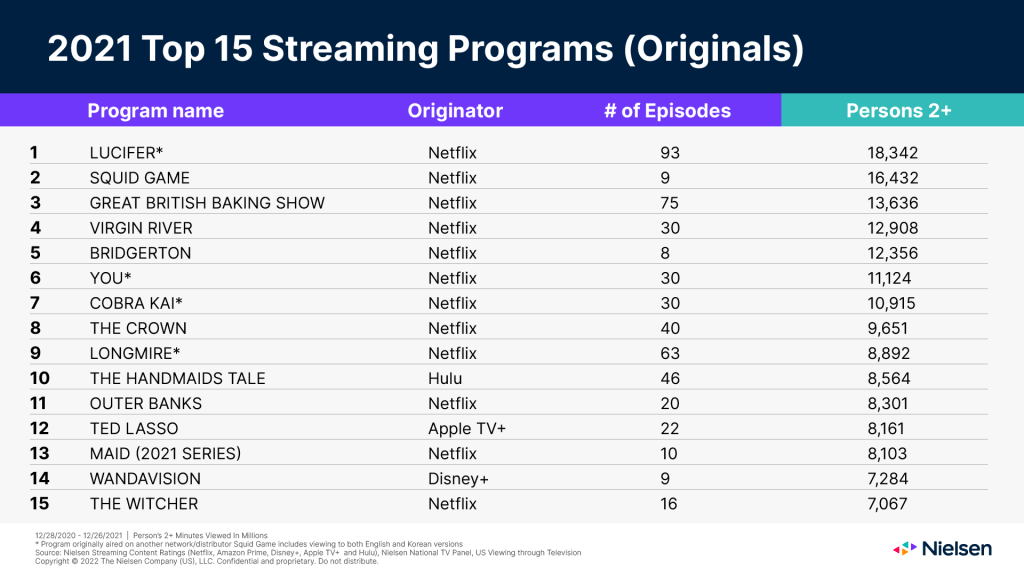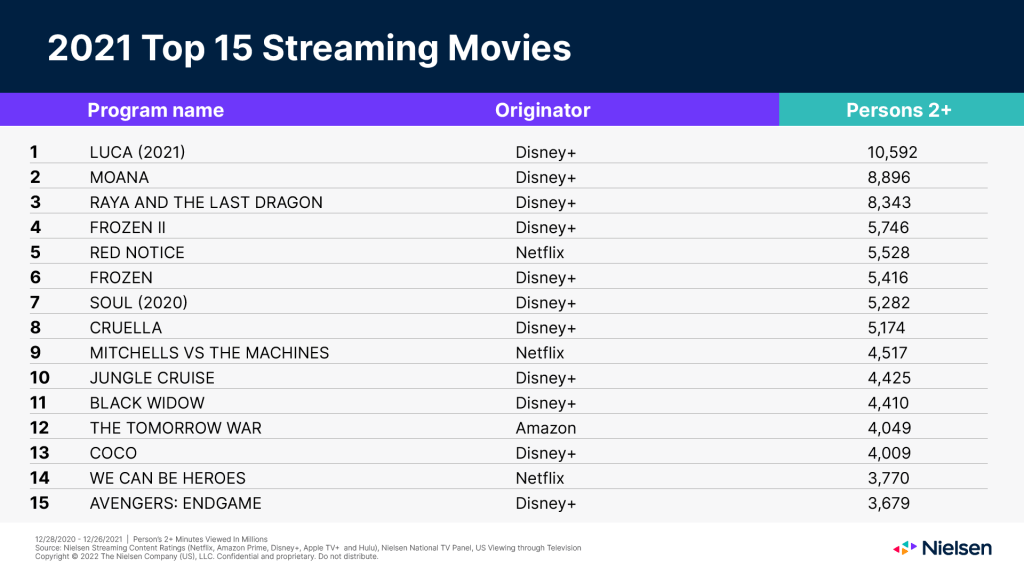Americans streamed almost 15 million years’ worth of content in 2021
In a year that continued to present audiences with an unprecedented variety of streaming platforms and content, U.S. consumers took full advantage of their options. In the last week of December 2021, audiences streamed 183 billion minutes, which even eclipsed the amount of time they spent streaming at the weekly height of COVID-driven lockdowns in early 2020 (166 billion minutes).
Fueled by significant increases in connectivity and appealing content across an ever-widening array of platforms, streaming services capitalized throughout the year on consumers’ growing appetite for over-the-top video content. In total, Americans streamed almost 15 million years’ worth of content in 2021. Despite the myriad options across the streaming landscape, consumers were most drawn to a few stand-outs, some of which simultaneously introduced audiences to content not focused on the U.S., such as the Great British Baking Show, Squid Game and Luca.
Across platforms, mystery, drama, reality and children’s programming were largely in the driver’s seat in 2021’s tops of streaming lists. In the original category, Lucifer benefits from having 93 episodes available to consumers, which commanded more than 18 billion viewing minutes throughout the year, closely followed by The Great British Baking Show. Notably, the prominence of Criminal Minds on the acquired list highlights the resonance of good content, regardless of which platform it’s developed for—and notwithstanding the notable headlines that popular streaming programs attract. And when we consider that 73% of U.S. households have access to Netflix (per Nielsen panel data), the availability of this acquired content on the platform has the potential to reach an entirely new audience base—much of which is streamers aged 18-34.
Seinfeld’s move to Netflix is another example of a program that’s attracting new audiences, with 41% aged 34 and younger—too young to have even been alive or watched it when the show first aired on broadcast TV. Today, 80% of the viewers of the 90’s classic “show about nothing” are under the age of 50.
2021 was also the year of breakthrough for international streaming content. With only nine episodes available, Korean series Squid Game on Netflix racked up an incredible 13 million-plus viewing minutes among U.S. audiences. The audience for this program skewed younger than the Netflix average, as 37% of viewers were 18-34. Lucifer and The Great British Baking Show appealed to a very similar streaming audience, with the two programs’ viewership skewing mostly female and evenly split across the 18-34, 35-49, and 50-64 age demographics. Amid the competition for audiences, our 2021 streaming unwrapped data shows that original content has more appeal among older audiences while acquired content has higher appeal among younger viewers.
Given the strain the pandemic placed on the traditional movie theater industry, streaming platforms provided audiences the opportunity to enjoy the latest theatrical productions from the comfort of their own homes. This was a boon for kids, as four of the most-streamed movies were animated children’s films. In addition to doing well with kids, the movies on this year’s list also introduced audiences to a level of diversity that speaks to the growing need for on-screen inclusion and diversity. In fact, five of the most-streamed movies on this year’s list featured diverse lead characters. From a platform perspective, the movie category is where Disney+ shined, as it distributes 11 of the top 15 movies on the list.
The unfolding story of streaming remains the most high-stakes and compelling across the media ecosystem, with an increasing amount of choice for consumers. But as we have seen this year, content libraries, bolstered by high-profile originals and popular children’s movies, are critical to gaining viewers’ attention. Penetration is the other driving force, as it allows companies to promote additional content to users to keep them engaged. The dynamics of price (free vs. ad supported) may have an increasing role as more competition enters the fray. Similar to what happened to expanding cable packages, consumer decisions will be made as to which services are retained and which are discontinued or replaced.



Brian Fuhrer, Nielsen’s SVP of Product Strategy and Thought Leadership, takes a look back at the top streaming programs of 2021.


